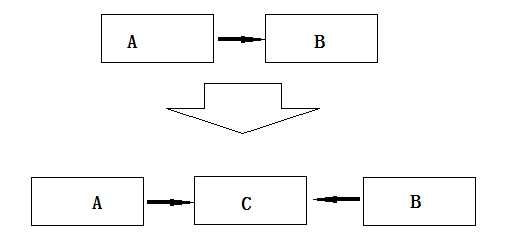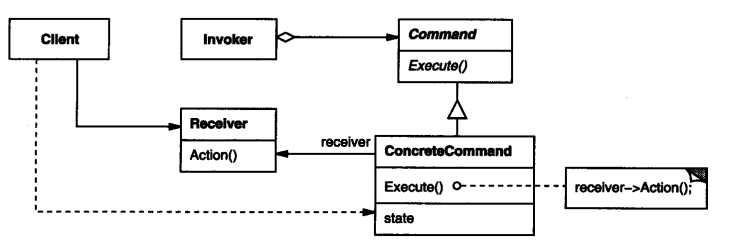标签:
Command 命令模式(行为型模式)
耦合与变化
耦合是软件不能抵御变化的根本性原因。不仅实体对象与实体对象之间存在耦合关系,实体对象与行为操作之间也存在耦合关系。
动机(Motivation)
在软件构建过程中,“行为请求者”与“行为实现者”通常呈现一种“紧耦合”。但在某些场合——比如对行为进行“记录、撤销/重做(undo/redo)、事务”等处理,这种无法抵御变化的紧耦合是不合适的。
在这种情况下,如何将“行为请求者”与“行为实现者”解耦?将一组行为抽象为对象,可以实现二者之间的解耦。
意图(Intent)
将一个请求封装为一个对象,从而使你可用不同的请求对客户(行为的请求者)进行参数化:对请求排队或记录请求日志,以及可以支持撤销的操作。——《设计模式》GoF
演化
开始时A依赖于行为B,为了分离A和B,加入了抽象类(或接口)C,使A依赖于C,B也依赖于C。

示例代码
//已存在,实现细节,低层实现 class Document { public void ShowText() { //... } } //已存在,实现细节,低层实现 class Graphics { public void ShowGraphics() { //... } } class Application { public void Show() { Document doc =new Document(); doc.ShowText();//直接依赖具体行为实现 Graphics graph=new Graphics(); graph.ShowGraphics();//直接依赖具体行为实现 } }
由于Application直接依赖于Document和Graphics,为了实现和具体行为的解耦,演化出如下代码:
//实现Command模式,抽象体 public interface ICommand { void Show(); } //具体化的命令对象——从抽象意义来讲,DocumentCommand表示一个行为 class DocumentCommand : ICommand { private Document document; public DocumentCommand(Document doc) { this.document = doc; } public void Show() { document.ShowText(); } } class GraphicsCommand : ICommand { private Graphics graphics; public GraphicsCommand(Graphics graph) { this.graphics = graph; } public void Show() { graphics.ShowGraphics(); } } class Application { private IList<ICommand> cmdList; public void Show() { foreach (var cmd in cmdList) { cmd.Show();//依赖于抽象 } } }
结构(Structure)

其中Command相当于上面代码的ICommand
ConcreteCommand相当于DocumentCommand和GraphicsCommand,它的Execute()方法相当于Show()。
Receiver相当于Document和Graphics
Command模式的几个要点
转载请注明出处:
作者:JesseLZJ
出处:http://jesselzj.cnblogs.com
标签:
原文地址:http://www.cnblogs.com/jesselzj/p/4771886.html